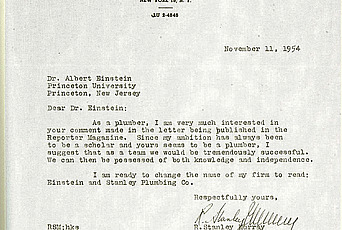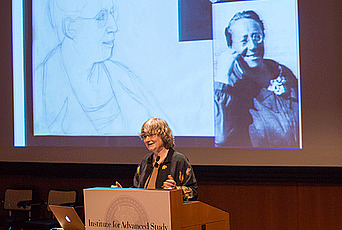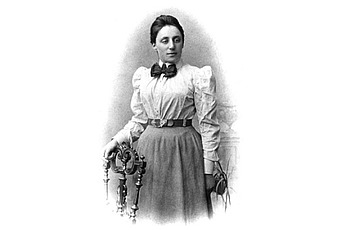Emmy Noether’s Paradise

To Albert Einstein, she was “the most significant creative mathematical genius thus far produced since the higher education of women began.” More straightforward in his praise, Einstein’s fellow Professor at the Institute for Advanced Study, Hermann Weyl, called her a “great woman mathematician […indeed] the greatest that history has known.” It was April 1935, and Einstein and Weyl were each paying tribute to a recently deceased colleague who had, like them, fled Nazi persecution across the Atlantic only two years earlier. Her name was Emmy Noether, and her short but remarkable life left an indelible mark not only on the history of mathematics, but also on that of IAS in its critical first years.
A woman in Göttingen
Amalie Emmy Noether was born in 1882 into an affluent family from the Bavarian town of Erlangen. She followed her father’s footsteps to study mathematics at the University of Erlangen and, in 1907, she became the second woman to obtain a Ph.D. in mathematics from a German university. A female maverick in a man’s world, Noether taught for several years without pay before being invited, in 1915, to join the University of Göttingen, home to the most prestigious mathematics department in the world at the time. She lectured for other professors and was only allowed to pass her habilitation following the collapse of the Kaiserreich and sweeping university reforms in 1919. Noether became an adjunct professor in 1922—the first female professor in Germany—but only started receiving a modest compensation for her teaching the following year. Despite international recognition, she never obtained a permanent position in Göttingen, and her situation took a turn for the worst with the rise to power of the Nazi party. In 1932, she was denounced by a neighbor as a “Marxist Jewess” and had to leave her apartment. The following year, she was removed from all teaching duties at the university and was eventually forced to flee Germany like many other purged academics. Thanks to the intervention of the Emergency Committee in Aid of Displaced German Scholars (set up in 1933 by the Institute for International Education in New York City and later renamed to include all Foreign Scholars) Noether was able to take a temporary position at Bryn Mawr College. Once in Pennsylvania, she reconnected with her former Göttingen colleague Weyl, himself freshly recruited to the Institute for Advanced Study by its first Director Abraham Flexner and resident Professors Oswald Veblen and Einstein.
A most significant creative mathematical genius
It was during her years in Göttingen that Emmy Noether developed an international reputation as a formidable mathematician. She made seminal contributions to the field of “abstract algebra,” where she identified a simple, yet elegant, property of number systems, which proved instrumental in the study of arithmetic and geometric phenomena such as prime decomposition and dimension. Noether brought similar clarity to her pioneering research in physics, where she understood the relationship between symmetries of the laws of nature and the notion of “conservation laws.” As an illustration, consider the “principle of energy conservation,” a paradigmatic conservation law, which states that the total “energy” of an isolated system cannot change. When a car accelerates, for instance, its energy increases, implying that it must have drawn energy from somewhere, according to the principle of energy conservation (in this case, from burning gasoline). On the other hand, consider “time-translation invariance,” a fundamental symmetry of the laws of nature, which states that an experiment performed today would give the same outcome if performed tomorrow: the speed of a free-falling cannonball is the same now as it was in the time of Galileo. Noether was able to connect these two seemingly unrelated concepts: energy conservation comes from time-translation invariance and vice versa. Scientists had long known the connection between energy and time, but Noether was the first to theorize a systematic correspondence: symmetries and conservation laws are related, in general. The idea arose out of a debate between David Hilbert, Felix Klein, and Albert Einstein over the notion of energy in Einstein’s recently formulated general theory of relativity. Noether’s theorem not only laid this controversy to rest, but, due to its striking generality, has been widely used in many other fields of physics, perhaps most notably in the study of elementary particles.
Rethinking the scholar’s paradise in the 1930s
Emmy Noether was thus already a household name among mathematicians when Veblen approached Flexner about supporting her in the United States. Their personal correspondence reveals how the Institute was forced to reconsider its mission in the face of unprecedented assaults on scholars in Europe. Noether’s position at Bryn Mawr was funded by the Rockefeller Foundation (as part of their $1.5 million aid package for displaced scholars) but was only temporary. At Veblen’s invitation, she began giving weekly lectures at the Institute as a Visitor in the School of Mathematics, where she joined the first cohort of IAS Members. Noether was happy to be at the Institute—and not at Princeton’s “men’s university, where nothing female is admitted,” as she once said—but she didn’t receive any honorariums for her lectures, unlike seventeen other occasional visiting lecturers, all male, who spoke at the Institute throughout the 1930s. On the other hand, Veblen did request a “small grant-in-aid,” to help keep her at Bryn Mawr through 1935 and 1936, on the grounds of “Miss Noether’s unique position in the world as the only woman mathematician of the first rank.” Flexner was sympathetic to Noether’s plight, but worried about the Institute overcommitting, and he repeatedly encouraged Veblen to view the question as an administrator (a crucial step, in his opinion, in establishing a credible system of faculty governance). Flexner wondered what such a short-term commitment could achieve and expressed concern at the Institute doing any more than what it already had for German scholars, as it needed to be “careful not to create the impression that [it was] overlooking Americans in order to help these unfortunate foreigners.” Sidestepping the thorny issue of nationality, Veblen was eventually able to secure a $1,500 grant and continued soliciting larger donations for a “permanent commitment on the part of the Institute.” As he put it, Noether was not merely unique as a “woman mathematician,” she offered the Institute an opportunity to capitalize on the brain-drain from Göttingen by supporting “one of the most important scientists” displaced by the events in Germany.
Assisting endangered scholars presented, in other words, as many opportunities as it entailed risks and burdens for the newly established IAS. Flexner himself came around to seeing this, albeit only after Noether’s untimely death on April 14, 1935. No doubt inspired by Weyl’s and Einstein’s stirring obituaries, he invoked her memory in a lecture on “The Usefulness of Useless Knowledge”—an idea he had long pursued and would, two years later, publish as his famous article in Harper’s magazine—that he gave at Bryn Mawr on June 2, 1937. Noether, he had come to believe, “was driven from Göttingen for no better reason than that she was a Jewess.” Bryn Mawr had “welcomed her with open arms,” as many other institutions had done for other scholars at risk across the country. “This is civilization,” Flexner concluded, “this is culture. . . . a country like America, of which only a small fraction has been culturally developed, can only be enriched by the folly which drives great thinkers, novelists, dramatists, and poets out of the Old World to make a fresh start in the New.” Flexner’s words ring loud today, as a reminder of how the Institute found a new raison d’être in challenging times, and as an admonition of how fragile and contingent “scholars’ paradises” such as the IAS, or Göttingen before it, can be.
References
IAS, Shelby White and Leon Levy Archives Center. Veblen-Flexner correspondence (Director’s Office: Faculty files: Box 32: Veblen, 1934–35); Flexner “The Usefulness of Useless Knowledge” (lecture given at Bryn Mawr College on June 2, 1937: https://library.ias.edu/files/UsefulnessOfUselessKnowledge.pdf); list of occasional lecturers from 1930s (Beatrice Stern research files: Vertical file: Box 4: “M”).
Katherine Brading, “A Note on General Relativity, Energy Conservation, and Noether’s Theorems,” The Universe of General Relativity, ed. A. J. Kox and J. Eisenstaedt (Boston: Birkhäuser, 2005): 125–135.
Albert Einstein, “Letter to the Editor [on Emmy Noether],” New York Times, May 5, 1935.
Auguste Dick, Emmy Noether, 1882–1935 (Boston: Birkhäuser, 1981).
Nathan Reingold, “Refugee Mathematicians in the United States of America, 1933–1941: Reception and Reaction,” Annals of Science 38 (1981): 313–338.
Peter Roquette, “Zu Emmy Noethers Geburtstag. Einige neue Noetheriana,” Mitteilungen der DMV 15 (2007): 15–21.
Cordula Tollmien, “Emmy Noether. ‘Die größte Mathematikerin, die jemals gelebt hat,’” Des Kennenlernens werth. Bedeutende Frauen Göttingens, ed. Traudel Weber-Reich (Göttingen: Wallstein Verlag, 1993): 227–247


